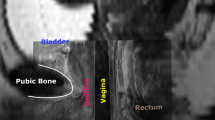Abstract
Selecting an IUD that fits the uterine dimensions is believed to be a keystone in improving IUD performance. This study included 15 women admitted for hysterectomy with no gross pelvic pathology distorting the uterine cavity and no contraindication to hysterography. Before hysterectomy the uterine cavity dimensions were measured using the Wing Sound II device and hysterography. After hysterectomy, direct measurements of the same dimensions were performed. The correlation between the Wing Sound II device measurements and those obtained by the direct method was highly significant except for the fundal transverse dimension where the correlation was moderately significant. On the other hand, hysterography measurements had a moderately significant correlation with those obtained by the direct method, except for the fundal transverse dimensions and the total uterine length where the correlation was insignificant. The Wing Sound II device is a simple, safe and accurate tool for studying uterine geometry on an out-patient basis.
Résumé
On pense que le choix d'un DIU qui convienne aux dimensions de l'utérus est un élément clé permettant d'améliorer l'efficacité du dispositif. L'étude présentée ici porte sur 15 femmes hospitalisées pour hystérectomie, sans importante pathologie pelvienne déformant la cavité utérine et sans contre-indication à l'hystérographie. Avant l'hystérectomie, les dimensions de la cavité utérine ont été mesurées à l'aide d'un appareil Wing Sound II et par hystérographie. Des mesures directes de ces mêmes dimensions ont été prises après l'intervention. La corrélation existant entre les mesures prises avec l'appareil Wing Sound II et celles obtenues par la méthode directe s'est révélée hautement significative, sauf en ce qui concernait la dimension tranversale du fond, où la corrélation n'était que modérément significative. D'autre part, les mesures de l'hystérographie n'ont donné qu'une corrélation modérément significative avec celles obtenues par mensuration directe, sauf pour la dimension transversale du fond, où la corrélation était insignifiante. L'appareil Wing Sound II est un instrument simple, sûr et précis pour l'étude de la géométrie utérine chez des patientes en consultations externes.
Resumen
Se cree que la selección de un DIU que se adapte a las dimensiones del utero es la clave para mejorar su acción. Este estudio incluye 15 muheres internadas por histerectomías, carentes de mayor patología pelviana que pudiera distorsionar la cavidad uterina y, sin contraindicaciones para histerografía. Antes de la histerectomía se tomaron las dimensiones de la cavidad uterina usando la Wing Sound II e histerografía. Después de la histerectomía se tomaron medidas directas de la mismas dimensiones. La correlación entre las medidas con la Wing Sound II y las obtenidas por el método directo, fué altamente significativo con excepción de la dimension transversal del fondo, donde la correlación fué moderadamente significativa. Por otra parte, las medidas histerográfias tuvieron una correlación moderadamente significativa con las obtenidas por el método directo, con excepción de la dimensión transversal del fondo y la longitud uterina total donde la correlación fué no significativa. La Wing Sound es un instrumento sencillo, seguro y preciso para estudiar la geometría uterina en pacientes externas.
Similar content being viewed by others
References
HassonH.M. (1983). Uterine geometry and IUD performance. In: Long-acting Contraception GoldsmithA., ToppozadaM., eds. Chicago, Northwestern University, pp. 157–66
ThomasM.N. (1981). Uterine metrology devices for IUD selection. Piact Product News,3(2), 1–4
ToppozadaM.K. (1981). Gynaecological and Obstetrical Instruments. Alexandria, Dar Al-Maaref, pp. 21–2
Laufe, L. (1981). Report to Battelle IUD subcommittee meeting Chicago, 1974. Quoted in Thomas, M.N. Uterine metrology devices for IUD selection. Piact Product News,3(2), 1–4
Zipper, J. (1981). Personal communication to Wheeler, R.G., 1978. Quoted in Thomas, M.N. Uterine metrology devices for IUD selection. Piact Product news,3(2), 1–4
KurzK.H. (1981). IUD physiology: Avoidance of the dimensional incompatibility as the main reason for side effects in intrauterine contraception. Contracept. Deliv. Syst.,2, 21–9
HassonH.M. and DershinH. (1981). Assessment of uterine shape by geometric means. Contracept. Deliv. Syst.,2, 59–75
Hasson, H.M. (1982). Personal communication, letter to Prof. M.K. Toppozada 27 July
HassonH.M. (1985). Clinical studies of the Wing Sound II metrology device. In: Intrauterine Contraception, G.I.Zatuchni, A.Goldsmith and J.J.Sciarra, eds., Harper and Row., Philadelphia, pp. 126–141
HassonH.M. (1980). Uterine geometry and IUD performance. In: Medicated Intrauterine Devices. Physiological and Clinical Aspects. HafezE.S.E., VanOsWAA, eds. The Hague: Martinus Nijhoff Publishers pp. 185–94
TejujaS. and MalkaniP.K. (1969). Clinical significance of correlation between size of uterine cavity and IUCD. A study by planimeter hysterogram technique. Am. J. Obstet. Gynecol.,105(4), 620–7
BurnhillM.S. and BirnbergC.H. (1966). The size and shape of the uterine cavity determined by hysterography with an intrauterine contraceptive device as a marker. Int. J. Fertil.,11(2), 187–93
PiiroinenO. and KaivolaH.L. (1975). Uterine size measured by ultrasound during the menstrual cycle. Acta. Obstet. Gynecol. Scand.,54, 247–50
HassonH.M. (1975). Ballooned uterine elevator cannula. Am. J. Obstet. Gynecol.,123(6), 658–9
LewisR.B. and ZuspanF.P. (1970). A method for determining counter volume of the uterine cavity. Contraception,2(4), 249–57
Author information
Authors and Affiliations
Rights and permissions
About this article
Cite this article
Ismail, A.A.A., Anwar, M.Y., Keshk, S.M. et al. Uterine geometry by Wing Sound and hysterography versus direct measurements. Adv Contracept 3, 237–243 (1987). https://doi.org/10.1007/BF01849397
Received:
Accepted:
Issue Date:
DOI: https://doi.org/10.1007/BF01849397




